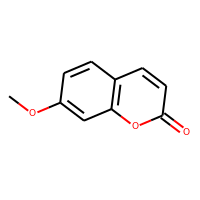
7-Methoxycoumarin
| Chemical identification | |
|---|---|
| Pubchem identifier | 10748 |
| CAS identifier | 531-59-9 |
| DSSTOX identifier | DTXSID5060196 |
| IUPAC name | 7-Methoxycoumarin |
| SMILES | COC1=CC2=C(C=C1)C=CC(=O)O2 |
| InChI | InChI=1S/C10H8O3/c1-12-8-4-2-7-3-5-10(11)13-9(7)6-8/h2-6H,1H3 |
| InChIKey | LIIALPBMIOVAHH-UHFFFAOYSA-N |
| Synonyms | Ayapanin; Herniarine; 7-Methoxycoumarin; Herniarin (6CI); METHOXYCOURMARIN, 7-; 7-Methoxy-2H-1-benzopyran-2-one; Methylumbelliferone; Herniarin; 2H-1-Benzopyran-2-one, 7-methoxy- |
| Odor profile | |
|---|---|
| Odor classes | Aromatic, Berry, Citrus, Dairy, Edible oil, Fermented, Floral, Fruity, Grain, Herbs, Maillard, Mineral, Pome, Stone spices, Sweet spices, Vegetable |
| Reference | [1] |
| Presence in Children's products | |
|---|---|
| Broad category | Toys |
| Subcategory | Clay Toys, Plush Toys, Miscellaneous Toys |
| Chemical classification based on ClassyFire | |
|---|---|
| Chemical kingdom | Organic compounds |
| Chemical super-class | Phenylpropanoids and polyketides |
| Chemical class | Coumarins and derivatives |
| Chemical subclass | Not available |
| Natural source for the chemical | |||
|---|---|---|---|
| Organism | Kingdom | Genus | Family |
| Artemisia dracunculus | Plantae | Artemisia | Asteraceae |
| Herniaria glabra | Plantae | Herniaria | Caryophyllaceae |
| Eupatorium triplinerve | Plantae | Eupatorium | Asteraceae |
| Carum carvi | Plantae | Carum | Apiaceae |
| Melilotus indica | Plantae | Melilotus | Fabaceae |
| Puccinia graminis | Fungi | Puccinia | Pucciniaceae |
| Matricaria chamomilla | Plantae | Matricaria | Asteraceae |
| Reference | [1], [2], [3] | ||